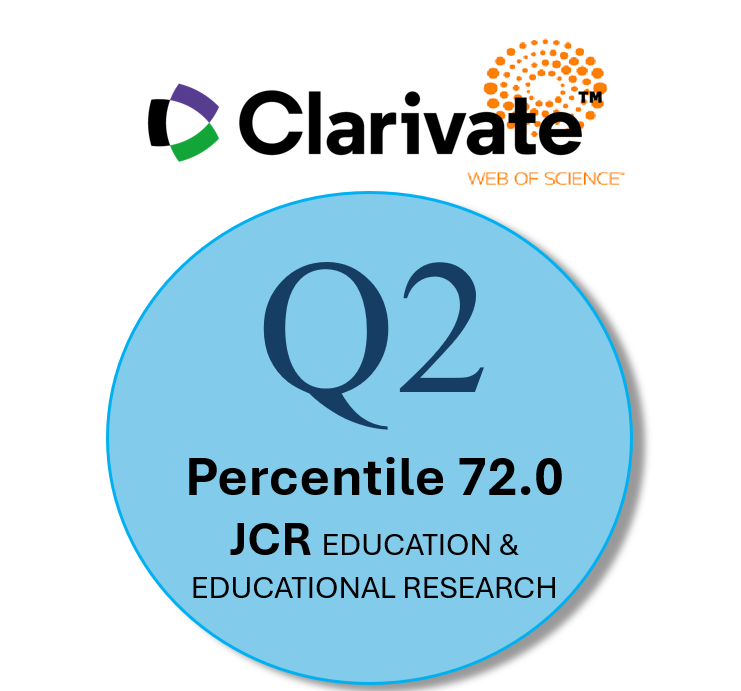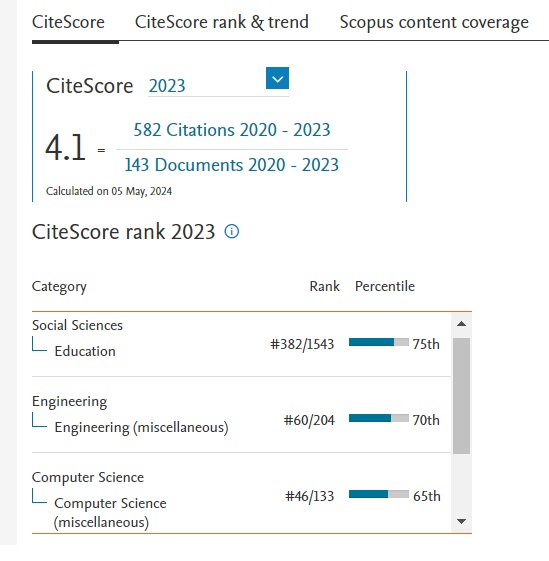Panorama actual de la investigación en educación a distancia: un estudio bibliométrico
Resumen
En este artículo se analiza la evolución de la educación a distancia, la producción de sus investigadores y su impacto. Para ello, se han aplicado técnicas bibliométricas, como el análisis de rendimiento y el mapeo científico, a 40 revistas seleccionadas como las más relevantes en la base de datos de Scopus con un filtro temporal de 2018 a 2022. El resultado de la búsqueda fue 12,947 artículos analizados con la herramienta de análisis de mapeo científico (SciMAT). Por un lado, el análisis de rendimiento identificó un aumento significativo en el número de publicaciones, de 1,943 en 2018 a 3,512 en 2022 (80,75%), con una notable concentración de revistas en Europa (55%) y América del Norte (35%); por otro lado, la afiliación de los 10 autores más impactantes (citas, índice h y FWCI) se encuentra predominantemente en Asia. Mediante el mapeo científico identifica dos temas candentes: la pandemia de COVID-19, de la que se intensificó la publicación en 2020, y la realidad virtual, que apareció en 2022. Los temas relacionados con los estudiantes son de gran interés pora la comunidad y tienen un papel fundamental en las publicaciones. Finalmente, se detectó que existe una consolidación de las palabras clave y que hay una interconexión entre varios temas implicando un enfoque multidisciplinario en el estudio de la educación a distancia.
Descargas
-
Resumen696
-
PDF 784
Citas
Adedoyin, O. B., & Soykan, E. (2020). Covid-19 pandemic and online learning: the challenges and opportunities. Interactive Learning Environments. https://doi.org/10.1080/10494820.2020.1813180
Akçayır, G., & Akçayır, M. (2018). The flipped classroom: A review of its advantages and challenges. Computers and Education, 126, 334–345. https://doi.org/10.1016/j.compedu.2018.07.021
Almaiah, M. A., Al-Khasawneh, A., & Althunibat, A. (2020). Exploring the critical challenges and factors influencing the E-learning system usage during the COVID-19 pandemic. Education and Information Technologies, 25(6), 5261–5280. https://doi.org/10.1007/s10639-020-10219-y
Börner, K., Chen, C., & Boyack, K. W. (2003). Visualizing knowledge domains. Annual Review of Information Science and Technology, 37, 179–255. https://doi.org/10.1002/aris.1440370106
Bitzenbauer, P. (2021). Quantum physics education research over the last two decades: a bibliometric analysis. Education Sciences, 11(11), 699. https://doi.org/10.3390/educsci11110699
Callon, M., Courtial, J. P., & Laville, F. (1991). Co-word analysis as a tool for describing the network of interactions between basic and technological research: The case of polymer chemistry. Scientometrics, 22(1), 155–205. https://doi.org/10.1007/BF02019280
Cobo, M. J., López-Herrera, A. G., Herrera-Viedma, E., & Herrera, F. (2011a). An approach for detecting, quantifying, and visualizing the evolution of a research field: A practical application to the Fuzzy Sets Theory field. Journal of Informetrics, 5(1), 146–166. https://doi.org/10.1002/asi.21525
Cobo, M. J., López-Herrera, A. G., Herrera-Viedma, E., & Herrera, F. (2011b). Science mapping software tools: Review, analysis, and cooperative study among tools. Journal of the American Society for Information Science and Technology, 62(7), 1382–1402. https://doi.org/10.1002/asi.21525
Cobo, M. J., López-Herrera, A. G., Herrera-Viedma, E., & Herrera, F. (2012). SciMAT: A new science mapping analysis software tool. Journal of the American Society for Information Science and Technology, 63(8), 1609–1630. https://doi.org/10.1002/asi.22688
Cobo, M. J., F. Chiclana, A. Collop, J. de Ona and E. Herrera-Viedma, "A Bibliometric Analysis of the Intelligent Transportation Systems Research Based on Science Mapping," in IEEE Transactions on Intelligent Transportation Systems, vol. 15, no. 2, pp. 901-908, April 2014. https://doi.org/10.1109/TITS.2013.2284756
Coulter, N., Monarch, I., & Konda, S. (1998). Software Engineering as Seen through Its Research Literature : A Study in Co-Word Analysis. Journal of the American Society for Information Science, 4571(January). https://doi.org/10.1002/(SICI)1097-4571(1998)49
Debackere, K., Verbeek, A., Luwel, M., & Zimmermann, E. (2002). Measuring progress and evolution in science and technology - II: The multiple uses of technometric indicators. International Journal of Management Reviews, 4(3), 213–231. https://doi.org/10.1111/1468-2370.00085
Dorta-González, P., & Dorta-González, M. I. (2010). Indicador bibliométrico basado en el índice h. Revista Espanola de Documentacion Cientifica, 33(2), 225–245. https://doi.org/10.3989/redc.2010.2.733
Donthu, N., Kumar, S., Mukherjee, D., Pandey, N., & Lim, W. M. (2021). How to conduct a bibliometric analysis: An overview and guidelines. Journal of Business Research, 133(April), 285–296. https://doi.org/10.1016/j.jbusres.2021.04.070
Donthu, N., Reinartz, W., Kumar, S., & Pattnaik, D. (2021). A retrospective review of the first 35 years of the International Journal of Research in Marketing. International Journal of Research in Marketing, 38(1), 232–269. https://doi.org/https://doi.org/10.1016/j.ijresmar.2020.10.006
Dziuban, C., Graham, C. R., Moskal, P. D., Norberg, A., & Sicilia, N. (2018). Blended learning: the new normal and emerging technologies. International Journal of Educational Technology in Higher Education, 15(1). https://doi.org/10.1186/s41239-017-0087-5
Eck, N. J. van, & LudoWaltman. (2009). How to Normalize Cooccurrence Data? An Analysis of SomeWell-Known Similarity Measures. Journal of the American Society for Information Science and Technology, 60(8), 1635–1651. https://doi.org/10.1002/asi
Fahimnia, B., Sarkis, J., & Davarzani, H. (2015). Green supply chain management: A review and bibliometric analysis. International Journal of Production Economics, 162, 101–114. https://doi.org/10.1016/j.ijpe.2015.01.003
Guerrero-Bote, V. P., & Moya-Anegón, F. (2012). A further step forward in measuring journals' scientific prestige: The SJR2 indicator. Journal of Informetrics, 6(4), 674–688. https://doi.org/10.1016/j.joi.2012.07.001
Herrera-Viedma, E., López-Robles, J. R., Guallar, J., & Cobo, M. J. (2020). Global trends in coronavirus research at the time of COVID-19: A general bibliometric approach and content analysis using SciMAT. Profesional de La Informacion, 29(3), 1–20. https://doi.org/10.3145/epi.2020.may.22
Hossain, S., Batcha, M. S., Atoum, I., Ahmad, N., & Al-Shehri, A. (2022). Bibliometric Analysis of the Scientific Research on Sustainability in the Impact of Social Media on Higher Education during the COVID-19 Pandemic. Sustainability (Switzerland), 14(24). https://doi.org/10.3390/su142416388
Ibáñez, M.-B., & Delgado-Kloos, C. (2018). Augmented reality for STEM learning: A systematic review. Computers and Education, 123, 109–123. https://doi.org/10.1016/j.compedu.2018.05.002
Jensen, L., & Konradsen, F. (2018). A review of the use of virtual reality head-mounted displays in education and training. Education and Information Technologies, 23(4), 1515–1529. https://doi.org/10.1007/s10639-017-9676-0
Khan, F. M., & Gupta, Y. (2022). A bibliometric analysis of mobile learning in the education sector. Interactive Technology and Smart Education, 19(3), 338–359. https://doi.org/10.1108/ITSE-03-2021-0048
Machado, C. F., & Davim, J. P. (2022). Higher Education for Sustainability: A Bibliometric Approach—What, Where and Who Is Doing Research in This Subject? Sustainability (Switzerland), 14(8). https://doi.org/10.3390/su14084482
Marín Suelves, D., Cuevas Monzonís, N., & Gabarda Méndez, V. (2021). Competencia digital ciudadana: análisis de tendencias en el ámbito educativo. RIED. Revista Iberoamericana de Educación a Distancia, 24(2), 329. https://doi.org/10.5944/ried.24.2.30006
Martin, F., & Bolliger, D. U. (2018). Engagement matters: Student perceptions on the importance of engagement strategies in the online learning environment. Online Learning Journal, 22(1), 205–222. https://doi.org/10.24059/olj.v22i1.1092
Moed, H. F. (2009). Measuring contextual citation impact of scientific journals. ArXiv, 4(3). https://doi.org/10.48550/arXiv.0911.2632
Moral-Muñoz, J. A., Herrera-Viedma, E., Santisteban-Espejo, A., & Cobo, M. J. (2020). Software tools for conducting bibliometric analysis in science: An up-to-date review. El Profesional de La Información, 29(1), 1–20. https://doi.org/10.3145/epi.2020.ene.03
Page, M. J., McKenzie, J. E., Bossuyt, P. M., Boutron, I., Hoffmann, T. C., Mulrow, C. D., Shamseer, L., Tetzlaff, J. M., Akl, E. A., Brennan, S. E., Chou, R., Glanville, J., Grimshaw, J. M., Hróbjartsson, A., Lalu, M. M., Li, T., Loder, E. W., Mayo-Wilson, E., McDonald, S., … Moher, D. (2021). The PRISMA 2020 statement: an updated guideline for reporting systematic reviews. BMJ, n71. https://doi.org/10.1136/bmj.n71
Radianti, J., Majchrzak, T. A., Fromm, J., & Wohlgenannt, I. (2020). A systematic review of immersive virtual reality applications for higher education: Design elements, lessons learned, and research agenda. Computers and Education, 147. https://doi.org/10.1016/j.compedu.2019.103778
Santos, C., Pedro, N., & Mattar, J. (2024). Metadata of the Top 40 Journals in Distance Education: A Bibliometric Analysis of Impact 2018-2022 [Data set]. Zenodo. https://doi.org/10.5281/zenodo.11196054
Scherer, R., Siddiq, F., & Tondeur, J. (2019). The technology acceptance model (TAM): A meta-analytic structural equation modeling approach to explaining teachers' adoption of digital technology in education. Computers and Education, 128, 13–35. https://doi.org/10.1016/j.compedu.2018.09.009
Schmidt, F. (2008). Meta-analysis: A constantly evolving research integration tool. Organizational Research Methods, 11(1), 96–113. https://doi.org/10.1177/1094428107303161
Sherwood, G., Jones, C. B., Conklin, J. L., & Dodd, A. (2023). Quality and safety education for nurses: A bibliometric analysis. Journal of Nursing Scholarship, July 2022, 1–12. https://doi.org/10.1111/jnu.12876
Small, H. G. (1977). A Co-Citation Model of a Scientific Specialty: A Longitudinal Study of Collagen Research. Social Studies of Science, 7(2), 139–166. https://doi.org/10.1177/030631277700700202
Sternitzke, C., & Bergmann, I. (2009). Similarity measures for document mapping: A comparative study on the level of an individual scientist. Scientometrics, 78(1), 113–130. https://doi.org/10.1007/s11192-007-1961-z
Waltman, L., van Eck, N. J., van Leeuwen, T. N., & Visser, M. S. (2012). Some modifications to the SNIP journal impact indicator. Journal of Informetrics, 7(2), 272–285. https://doi.org/10.1016/j.joi.2012.11.011
Wu, Y. C. J., & Wu, T. (2017). A decade of entrepreneurship education in the Asia Pacific for future directions in theory and practice. Management Decision, 55(7), 1333–1350. https://doi.org/10.1108/MD-05-2017-0518
Zawacki-Richter, O., Marín, V. I., Bond, M., & Gouverneur, F. (2019). Systematic review of research on artificial intelligence applications in higher education – where are the educators? International Journal of Educational Technology in Higher Education, 16(1). https://doi.org/10.1186/s41239-019-0171-0
Zupic, I., & Čater, T. (2015). Bibliometric Methods in Management and Organization. Organizational Research Methods, 18(3), 429–472. https://doi.org/10.1177/1094428114562629
Derechos de autor 2024 Revista de Educación a Distancia (RED)

Esta obra está bajo una licencia internacional Creative Commons Atribución-NoComercial 4.0.
Las obras que se publican en esta revista están sujetas a los siguientes términos:
1. El Servicio de Publicaciones de la Universidad de Murcia (la editorial) conserva los derechos patrimoniales (copyright) de las obras publicadas, y favorece y permite la reutilización de las mismas bajo la licencia de uso indicada en el punto 2.
2. Las obras se publican en la edición electrónica de la revista bajo una licencia Creative Commons Reconocimiento-NoComercial-SinObraDerivada 3.0 España (texto legal). Se pueden copiar, usar, difundir, transmitir y exponer públicamente, siempre que: i) se cite la autoría y la fuente original de su publicación (revista, editorial y URL de la obra); ii) no se usen para fines comerciales; iii) se mencione la existencia y especificaciones de esta licencia de uso.
3. Condiciones de auto-archivo. Se permite y se anima a los autores a difundir electrónicamente las versiones pre-print (versión antes de ser evaluada) y/o post-print (versión evaluada y aceptada para su publicación) de sus obras antes de su publicación, ya que favorece su circulación y difusión más temprana y con ello un posible aumento en su citación y alcance entre la comunidad académica. Color RoMEO: verde.














